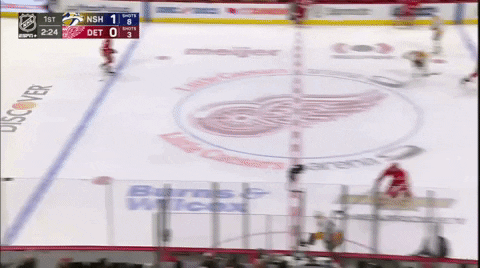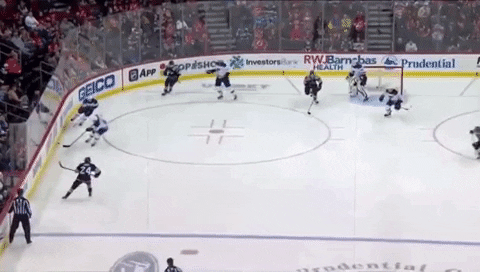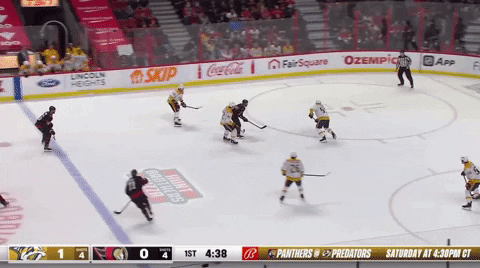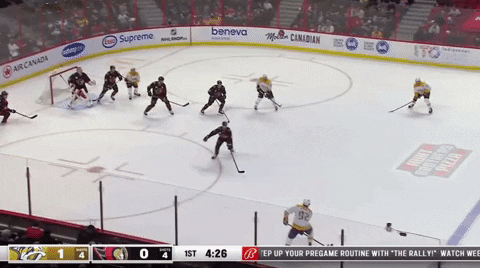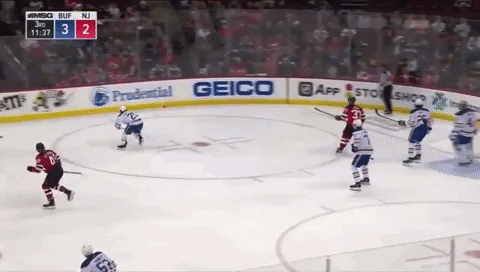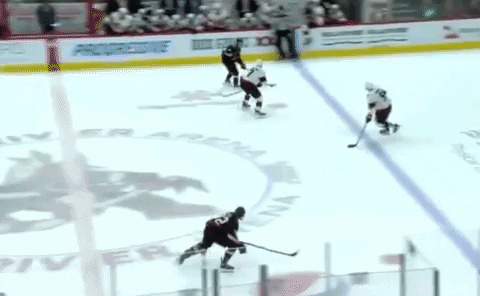Modern Hockey: Offensive Rush Tactics with Defenseman Roman Josi
Modern Offense = Defenseman Joining The Rush
Two things:
Scoring in the NHL is up this season. This seems almost counterintuitive given the amount of video scouting that goes into each game.
Did you know that hockey used to be played with 6 players on the ice per team? The Hockey Hall of Fame inducted 19 players under the “rover” position. Effectively the Rover roamed the ice surface to chip in everywhere.
New Trend
A large trend in hockey that has grown at all levels is defensemen playing like the old-fashioned rover via joining the rush or leading the rush. In hockey speech, you might hear of this as having an “active D.”

The most recent and biggest example would be Martin St Louis (MSL) and the Montreal Canadiens. Since MSL took over halfway through the season, the Canadiens started scoring… what changed? Their defensemen started playing like rovers! At every chance, defensemen are “activating” and quickly joining the offensive rush.
Defensemen Joining the Rush
Enter Roman Josi, the modern-day rover. Josi has won the Norris Trophy as the top NHL Defenseman and is definitely on the shortlist to win the award again. The other contender for the Norris is Cale Makar, who also plays as a rover-style defenseman.
In virtually any NHL season, defensemen fail to record a point per game. In 2021-22, Josi is at 1.22 points/game. While this year has been quite high-scoring, Josi being a large part of the offense isn’t new.
What is his secret? He is active in the play, and on any “funny” puck, he goes up the ice.
What perhaps started as an individual tactic has since become a team tactic. In coach speak you’ll hear “four in the rush” in basically any locker room. Let’s take a dive into the key concepts:
Sprinting
Beat the backcheck
Five in the picture
Even on exit
Replacing the center
Key Concept: Sprinting
Playing without hesitation is critical.
When Josi sees a “funny” puck, he sprints up the ice without hesitation. If he hesitates, there is a better chance to get beat out by an opponent, losing any jump he may have had on the play.
The other key component to sprinting is building a speed differential. This allows defensemen to cut through opponents like a hot knife through butter.
Top young defensemen like Mortiz Seider of the Detroit Red Wings are applying these tactics, as seen in the below video.
Key Concept: Beat the Backcheck
Keeping things simple, beating the backcheck is a great goal for defensemen. They need to get offensive-side positioning.
Here is a great example from Torey Krug (#47 white) of the St. Louis Blues. He starts at the backside post and even with the backchecker. He sprints hard to join the rush and beat the backchecking forward.
Key Concept: Five In The Picture
“The picture” is what a TV screen shows. Five in the picture means that all 5 players on the team should be available and an active part of the play. Compare this to players sitting back far away from the play and waiting to then read/react.
A great way to use vocabulary around this concept is “hunting.” Another great tactic in this concept is shorting the zone.
Mackenzie Weegar of the Florida Panthers is not the fastest skater, and neither is Zach Werenski of the Columbus Blue Jackets. Yet, they continue to produce and are top defensemen for their teams.
This is how Weegar went from being passed over at the OHL and NHL Drafts to being picked as a 7th-round NHL pick and spending his first professional season in the ECHL to finding his way as an impact NHL defenseman.
Key Concept: Even on Exit
A great measuring stick and goal for defensemen is to have their positioning “even on exit.”
The idea is that when the puck is received by the strong side winger on the wall, the weakside defenseman should be as far up the ice as that winger.
Key Concept: Replacing The Center
Centers often are busy helping the strong-side defender around the puck. Since they are outside of the dots, they are not in the ideal position to provide passing support.
You know who can be? The weakside defenseman!
This defenseman can easily take a step to position themselves as a viable passing option to support and start the breakout.
Roman Josi Sequence
Back to our hero, Josi. Here is a sequence from a recent game that illustrates his prowess to perfection.
Part 1: Rather than holding back and standing across the ice from his defensive partner, Josi starts to move up the ice despite the heavy pressure his teammate is receiving. Once pressure is broken, he is in a great position to receive the puck.
He is able to attack and dive deep into the offensive zone.
Part 2: Rather than rushing back, Josi ‘completes his route’ and maintains his speed. He is an option for a pass, cycle, rebound, or puck recovery.
This maintained speed then turns into Josi pressuring the puck via quality angling and forcing a turn back. Excellent!
Josi is truly an “Active D”/ Rover. This is modern-day defenseman play. You’ll see this with players like Maker, Seider, Jamie Drysdale, Quinn Hughes, Ramus Dahlin, and the top young defenseman coming into the NHL. Not convinced yet? Here is Owen Power’s first NHL goal.
Bonus Key Concept: Finding the 2nd Wave / The Trailer
All of these concepts talk about the defender joining the rush and being late. What is missing in this article is the puck carrier!
The puck carrier needs to be able to scan the ice, including the ice behind themselves. The carrier cannot be solely focused on getting the puck to the net.
Given the fact that teams overbackcheck or are lazy on the backcheck, there is a ton of time and space up high and late on rushes.
In the clip below, we see the 3v3 was defended well. The late D jumping into the play was the difference and led to the goal.
Why do I think scoring is up? There is more emphasis on ways to create offense and using all five players on the ice on the attack.
Further Reading
Zach Werenski lead the NHL in goals as a defender, how’d he do it?
Using passing progression to speed up effective decision making
Did you enjoy this newsletter?
Help us spread the ideas within and share it with the people you care about





